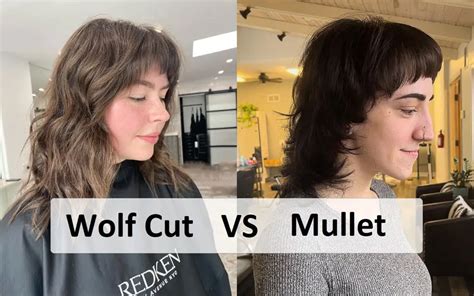Introduction

The wolf cut and the mullet, two iconic hairstyles that have made waves in the fashion industry, share striking similarities yet possess distinct nuances that set them apart. This article delves into a comprehensive comparison of these two hairstyles, exploring their origins, characteristics, styling techniques, and the factors that influence their popularity.
Origin and History
Wolf Cut
The wolf cut emerged in the 1980s as a more refined version of the shag haircut. It is characterized by its layered structure, shorter top layers, and longer bottom layers. The name “wolf cut” is derived from its resemblance to the fur of a wolf, with shaggy layers that create volume and texture.
Mullet
The mullet originated in the 1970s and gained popularity in the 1980s. It is known for its distinctive short hair on the top and sides, contrasted by longer hair at the back. The mullet’s versatility allowed it to be styled in various ways, from a short and choppy version to a longer and feathered one.
Characteristics
Wolf Cut
- Layered haircut with shorter top layers and longer bottom layers
- Shaggy texture with volume and body
- Can be styled with bangs or without
- Typically falls between the chin and shoulders
Mullet
- Short hair on the top and sides
- Longer hair at the back, often extending past the shoulders
- Can be styled with a tapered or blunt cut
- Typically falls below the shoulders
Styling Techniques
Wolf Cut
- Use a blow dryer to create volume and texture
- Apply texturizing products to enhance shagginess
- Can be styled with a round brush or a diffuser
- Can be parted in the middle or to one side
Mullet
- Use a flat iron or blow dryer to smooth the top and sides
- Apply hairspray or mousse to hold the style
- Can be styled with a comb or brush to create spikes or texture
- Can be tied back into a ponytail or a half-up style
Popularity and Trends
Wolf Cut
In recent years, the wolf cut has experienced a resurgence in popularity. It has become a go-to style for celebrities and fashion-forward individuals alike. Its versatility allows for customization, making it suitable for various hair types and face shapes.
Mullet
While the mullet was once a popular choice, it has seen a decline in popularity over the years. However, it remains a niche hairstyle that appeals to those who embrace individuality and a retro aesthetic.
Factors Influencing Popularity
Cultural Impact
Both the wolf cut and the mullet have been influenced by popular culture, including music, film, and fashion icons. The wolf cut has been associated with rock and roll musicians and grunge culture, while the mullet has been linked to country music and 1980s athleticism.
Personal Style
The popularity of these hairstyles also depends on personal style preferences. The wolf cut caters to those seeking a more modern and edgy look, while the mullet appeals to those who prefer a more rebellious or nostalgic aesthetic.
Hair Type and Texture
The suitability of the wolf cut and the mullet will vary depending on hair type and texture. The wolf cut is best suited for thicker hair, as it helps to create volume and texture. The mullet, on the other hand, can work well on both thick and thin hair textures.
Wolf Cut vs Mullet: A Table for Comparison
| Feature | Wolf Cut | Mullet |
|---|---|---|
| Length | Falls between chin and shoulders | Falls below shoulders |
| Layers | Layered with shorter top and longer bottom layers | Short on top and sides, longer at the back |
| Texture | Shaggy and textured | Smooth on top and sides, textured at the back |
| Styling | Blown out for volume, styled with texturizing products | Flat ironed or blow dried for smoothness, styled with hairspray or mousse |
| Customization | Can be styled with bangs or without, parted in the middle or to one side | Can be styled with a tapered or blunt cut, tied back into a ponytail or half-up style |
Which Hairstyle is Right for You?
The choice between a wolf cut and a mullet is a matter of personal preference. Consider your hair type, facial features, and desired style when making your decision. If you prefer a modern and edgy look with plenty of volume and texture, the wolf cut may be a suitable option. If you embrace a more rebellious or nostalgic aesthetic, the mullet may be a better fit.
Conclusion
The wolf cut and the mullet are both iconic hairstyles with unique characteristics and styling techniques. While they share similarities in terms of their layered structure and versatility, they also possess distinct features that set them apart. The popularity of these hairstyles has fluctuated over the years, influenced by cultural trends and personal style preferences. Ultimately, the choice between a wolf cut and a mullet depends on the individual’s desired look and hair type.
